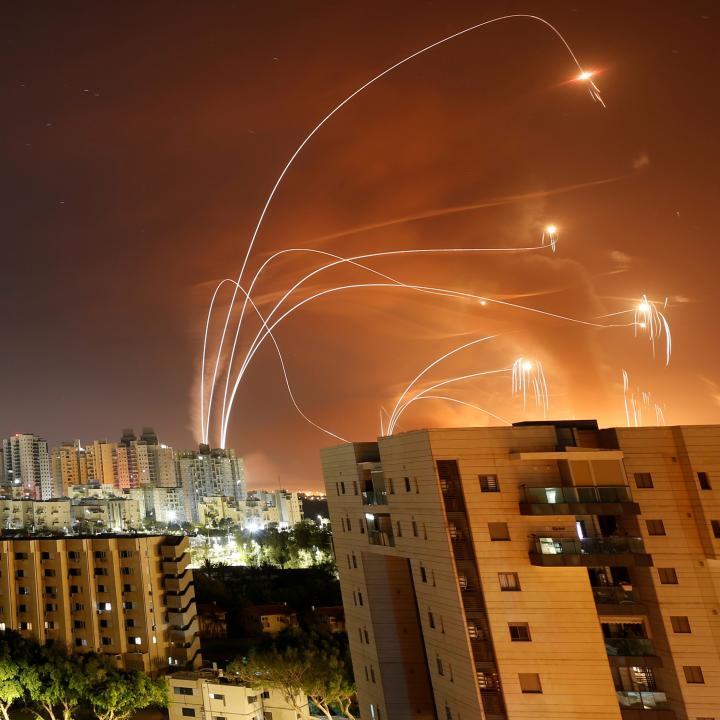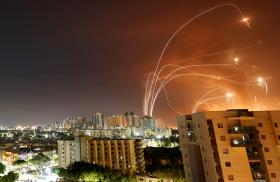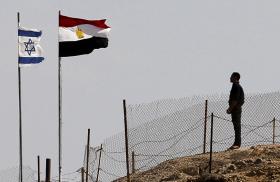
- Policy Analysis
- PolicyWatch 3865
How Sustainable Are Defense and Deterrence Methods in Light of Iran’s Attack?

Part of a series: Risks and Opportunities in the Post-April 13 Middle East
or see Part 1: The Palestinian Arena in the Shadow of the Iran-Israel Crisis
Despite the success of the allied response on April 13, Iran’s attack calls into question the sustainability of the current approach, suggesting that policymakers should rethink military procurement, force posture, and deterrence in the Middle East.
Iran’s decision to launch a direct, state-on-state attack against Israel on April 13 increased the risk of overt conventional conflict in the Middle East. This attack was significant in scope, scale, and complexity, employing hundreds of one-way attack drones, cruise missiles, and ballistic missiles. Equally significant was the U.S.-organized effort to defeat Iran’s attack, working with Israel as well as European and Arab allies to integrate capabilities and defend the region’s airspace. Although not publicly claimed, the April 19 Israeli response targeted air defenses protecting Iran’s nuclear program deep inside the country, without damage to civilian infrastructure or civilian casualties. And while the April 2024 escalation cycle appears closed, the region has now crossed the threshold for state-on-state attacks, with Israel and Iran both displaying potent capabilities and resolve.
The following article is part of a series that aims to shed light on the opportunities and risks of the post-April 13 strategic environment.
Iran’s April 13 attack on Israel was no mere demonstration, but rather a coordinated aerial assault. Fortunately, a well-executed, multinational integrated air and missile defense (IAMD) operation was able to counter it with resounding success, mainly for three reasons: (1) technological overmatch, (2) a large forward deployment of U.S. forces, and (3) a highly coordinated network of partners. Lest one think Tehran and its proxies lack options against allied defenses, however, each of these achievements comes with caveats that must be addressed to effectively deter Iran in the future.
The Attack and Defense
Over the course of the assault, more than 300 drones, missiles, and rockets were launched at Israel with estimated arrival times that spanned roughly six hours. In the first salvo, approximately 170 drones were launched from Iranian territory, followed a few hours later by thirty or so cruise missiles. In addition, Iran fired two salvos of ballistic missiles, around 110-130 in all. Meanwhile, Lebanese Hezbollah, the Yemeni Houthis, and various proxies in Iraq launched dozens more drones, missiles, and rockets from their territories.
In all, only four ballistic missiles appeared to penetrate Israeli defenses; no drones or other weapons reached their targets. This represents a 98 percent overall success rate for allied defenses, and a greater than 90 percent success rate specifically against Iranian ballistic missiles.
Details on which specific platforms were used to counter specific enemy munitions have not been disclosed, but open-source reporting and what is known about IAMD doctrine suggest that a combination of sea-, land-, and air-based platforms used kinetic and electromagnetic means (i.e., jamming) to destroy or disable them. This defensive effort was reportedly bolstered by a nearly 50 percent failure rate among the ballistic missiles Iran launched, which could have been caused by manufacturing flaws, poor military performance, sabotage, or other reasons.
The coalition of nations that defended against the attack have an arsenal of “exquisite” air defense systems—which is both a tactical benefit and a financial curse. Their preeminent aerial platform is the $100 million F-35 Lightning II stealth fighter, which can be armed with $1 million AIM-120 air-to-air missiles and $500,000 AIM-9s. Israeli F-35 variants and other coalition fighter aircraft made easy work of Iran’s suite of slow-flying drones (roughly $20,000-$50,000 per unit) and similarly inexpensive cruise missiles. From the ground, U.S. forces in Iraq employed at least one Patriot missile battery, whose interceptors cost $4 million each. In the Mediterranean Sea, two U.S. Arleigh Burke-class destroyers brought down a half-dozen missiles, likely with SM-3 interceptors that cost anywhere from $9.7 to $28 million depending on the variant employed. Israel also appeared to use its full suite of missile defense systems (David’s Sling, Arrow 2 and 3, Iron Dome), with interceptors that cost up to several million dollars each.
The successful defense also required the largest American presence in U.S. Central Command’s area of operations since the peak of the fight against the Islamic State. This deployment has stretched the limits of U.S. personnel and equipment, particularly at a time when the military is attempting to rebalance its force posture to support a National Defense Strategy that focuses on rising Chinese power in the Pacific. For example, the destroyer USS Carney had been deployed in the region for 200 days at the time of Iran’s attack, while the USS Eisenhower carrier group reached 183 days while supporting Operation Prosperity Garden, the mission to defend commercial shipping against Houthi attacks in the Red Sea. Meanwhile, though unconfirmed by the Department of Defense, more Patriot missile batteries have reportedly been operating in CENTCOM’s area of responsibility since October 7. Every additional battery is significant as there are only sixty in the active-duty inventory. This is a tremendous strain on a low-density/high-demand force that is nowhere near attaining the Pentagon’s mandated 1:2 deployment-to-dwell time ratio. Even before October 7, as many as 60 percent of the Army’s missile defense units were often deployed at one time.
Perhaps the most complicated ingredient for success was the network of partners coordinated through the U.S. Air Force’s Combined Air Operations Center (CAOC) at al-Udeid Air Base in Qatar. In 2022, Gen. Kenneth McKenzie, the head of CENTCOM at the time, identified IAMD as the best way to operationalize the Abraham Accords between Arab states and Israel—partly because all of these governments viewed the threat of Iranian missiles and drones as imminent, and also because IAMD was more achievable than other forms of integration, relying primarily on information sharing rather than hosting foreign forces. Indeed, Jordan, Saudi Arabia, and the United Arab Emirates reportedly assisted last month’s operation through information and intelligence sharing; Jordan also shot down multiple targets over its airspace, while multiple partners apparently granted overflight rights for U.S. Air Force operations.
Publicly, however, Saudi Arabia has downplayed or outright refuted its involvement in the operation, demonstrating the potentially tenuous nature of IAMD in the Middle East. Although regional governments recognize the threat posed by Iran and the benefits of cooperative defense arrangements, they must also manage hostile domestic opinion toward Israel.
Iran’s Post-Attack Options
The Iranian military undoubtedly learned a great deal from the attack—probing Israeli and coalition defenses created an opportunity to assess their capabilities, limitations, and how they operate together. Future strikes are likely to be better coordinated and use more munitions to overwhelm defenses.
Iran will also presumably try to break up the coalition it faced during this attack. This means driving wedges between Arab states and Israel while creating other pressures that erode America’s ability to maintain its regional presence.
In addition, the incident could make Tehran reconsider its weapons of mass destruction doctrine. If Israeli and coalition defenses are able to consistently intercept the vast majority of its conventional munitions, the regime may conclude that biological, chemical, or nuclear weapons are necessary to have any strategic effect.
U.S. Countermeasures
The most obvious means of maintaining an effective defense against Iranian threats is to invest in more air defenses—though not necessarily more capable or expensive ones. To cut U.S. costs while simultaneously creating denser, more innovative IAMD networks, Washington should prioritize Foreign Military Sales (FMS) to its partners in the region, including expanded sales and production of Patriot missile batteries, fighter aircraft (whether older models or the F-35, whose steep costs would come down if more were on order), and Terminal High-Altitude Area Defense systems (THAADs). At the same time, however, the United States must procure more inexpensive systems and explore other means of deterring Iran and its proxies, lest overinvestment in “exquisite” defensive capabilities creates the twenty-first-century equivalent of the Maginot Line.
Just days after Iran’s attack, Congress approved $95 billion in military aid for Israel, Taiwan, and Ukraine, including U.S.-manufactured air defense assets. This package represents a nearly 60 percent addition to the 2024 defense appropriations for U.S. military procurement. Going forward, CENTCOM, the Missile Defense Agency, and the State Department should foster collaboration among partners to integrate lessons learned from the Iran attack and the Ukraine war, and to identify new air defense requirements for FMS. By combining these additional requirements in the Pentagon’s Future Years Defense Program, by emphasizing that many of these additions could be paid for by partners, and by establishing new baselines of assistance for Taiwan and Ukraine, U.S. officials could send industry a clear signal of financial consistency, enabling it to ramp up production capacity.
Novel approaches to system development could help as well. Start-up companies should not be subject to antiquated protocols for testing, development, and evaluation that take years before a system can be fielded across U.S. forces, let alone be offered to partners. Instead, Washington should connect these firms with well-financed partner nations to refine their products in the field.
Although improving interception capabilities is important, another step may be even more crucial: transforming the CAOC from a regional coordinator into a fully integrated regional operations center. This means providing partners with more and better sensors while forging deeper cooperative agreements between them. In doing so, Washington should emphasize that such efforts are for the region’s collective security—Israel should not be a favored beneficiary of these arrangements, apart from urgent measures to safeguard it from the particularly imminent threats it faces.
Moreover, because the Iran attack represents a major shift in the Middle East’s strategic environment, the United States should respond by sending more defensive forces to the region, and more consistently. In 2023, Congress authorized up to twenty additional Patriot missile batteries for the Army; officials should make sure that the necessary funds are appropriated to actually reach this force level. They should also consider assigning more forces to CENTCOM’s area of operations rather than relying on rotational deployments. Establishing “normalized” tours for air defense artillery units and other forces that have perennially been deployed to CENTCOM could help deter Iran by demonstrating a resolute U.S. commitment to the region; it would also provide powerful leverage to dissuade partners from inviting China into their defense architectures.
Finally, policymakers should reevaluate the costs of various deterrence methods and adjust their approach accordingly. In recent years, they have relied quite heavily on deterrence by denial—that is, making sure adversaries like Iran are unable to effectively strike U.S. personnel or partners. This posture is ideal in many ways but costs a great deal and, as stated previously, requires a large forward presence for success; conversely, Iran has achieved inexpensive deterrence. Policymakers should therefore consider pairing denial with punishment, both threatened and actual. For example, in the event of a future attack, a counterstrike against Iran’s drone manufacturing capabilities could be particularly beneficial—not only by sending a strategic message to bolster deterrence, but also by degrading drone production, which would diminish the cost advantages of Iran’s approach and reduce the inventory available for arming its proxies and Russia.
Col. Andrew Clemmensen (USAF) is a 2023-24 military fellow at The Washington Institute. The conclusions and opinions expressed in this article do not necessarily reflect the official policy or position of the U.S. government, the Department of Defense, the U.S. Air Force, or Air University.





